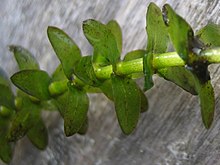Elodea canadensis: Difference between revisions
m robot Adding: no:Vasspest |
m fix |
||
| Line 22: | Line 22: | ||
It is closely related to ''[[Elodea nuttallii]]'', which generally has narrower leaves under 2 mm broad. It is usually fairly easy to distinguish from its relatives, like the Brazilian ''[[Egeria (genus)|Egeria densa]]'' and ''[[Hydrilla|Hydrilla verticillata]]''. These all have leaves in whorls around the [[Plant stem|stem]]; however, ''Elodea'' usually has three leaves per whorl, whereas ''Egeria'' and ''Hydrilla'' usually have four or more leaves per whorl. ''Egeria densa'' is also a larger, bushier plant with longer leaves.<ref name="nfp">Native Freshwater Plants: [http://www.ecy.wa.gov/programs/wq/plants/native/elodea.html American Waterweed]</ref> |
It is closely related to ''[[Elodea nuttallii]]'', which generally has narrower leaves under 2 mm broad. It is usually fairly easy to distinguish from its relatives, like the Brazilian ''[[Egeria (genus)|Egeria densa]]'' and ''[[Hydrilla|Hydrilla verticillata]]''. These all have leaves in whorls around the [[Plant stem|stem]]; however, ''Elodea'' usually has three leaves per whorl, whereas ''Egeria'' and ''Hydrilla'' usually have four or more leaves per whorl. ''Egeria densa'' is also a larger, bushier plant with longer leaves.<ref name="nfp">Native Freshwater Plants: [http://www.ecy.wa.gov/programs/wq/plants/native/elodea.html American Waterweed]</ref> |
||
| ⚫ | |||
- |
|||
<math>! header 1 |
|||
! header 2 |
|||
! header 3 |
|||
|- |
|||
| row 1, cell 1 |
|||
| row 1, cell 2 |
|||
| row 1, cell 3 |
|||
|- |
|||
| row 2, cell 1 |
|||
| row 2, cell 2 |
|||
| row 2, cell 3</math>[[Image:<math>Example.jpg</math> |
|||
Elodea Cultivation |
|||
| ⚫ | |||
It is frequently used as an [[aquarium]] plant. Propagation is by cuttings.<ref name="hiscock">Hiscock, P. (2003). ''Encyclopedia of Aquarium Plants'' Interpret Publishing, United States and Canada ISBN 0-7641-5521-0.</ref> |
It is frequently used as an [[aquarium]] plant. Propagation is by cuttings.<ref name="hiscock">Hiscock, P. (2003). ''Encyclopedia of Aquarium Plants'' Interpret Publishing, United States and Canada ISBN 0-7641-5521-0.</ref> |
||
Revision as of 19:13, 12 May 2008
| Elodea canadensis | |
|---|---|

| |
| Scientific classification | |
| Kingdom: | |
| Division: | |
| Class: | |
| Order: | |
| Family: | |
| Genus: | |
| Species: | E. canadensis
|
| Binomial name | |
| Elodea canadensis Michx.
| |
Elodea canadensis (syn. Anacharis canadensis (Michx.) Planch.; American or Canadian Waterweed or Pondweed), is a perennial aquatic plant, or submergent macrophyte, native to most of North America.[1][2][3]

Young plants initially start with a seedling stem with roots growing in mud at the bottom of the water; further adventitious roots are produced at intervals along the stem, which may hang free in the water or anchor into the bottom. It grows indefinitely at the stem tips, and single specimens may reach lengths of 3 m or more. The leaves are bright green, 6-17 mm long and 1-4 mm broad, borne in whorls of three (rarely two or four) round the stem. It lives entirely underwater, the only exception being the small white or pale purple flowers which float at the surface and are attached to the plant by delicate stalks. It is dioecious, with male and female flowers on different plants. The flowers have three small white petals; male flowers have 4.5-5 mm petals and nine stamens, female flowers have 2-3 mm petals and three fused carpels. The fruit is an ovoid capsule, about 6 mm long containing several seeds that ripen underwater. The seeds are 4-5 mm long, fusiform, glabrous (round), and narrowly cylindrical.[1][2][3][4]
It grows rapidly in favorable conditions and can choke shallow ponds, canals, and the margins of some slow-flowing rivers. It requires summer water temperatures of 10-25 °C and moderate to bright lighting.[4]
It is closely related to Elodea nuttallii, which generally has narrower leaves under 2 mm broad. It is usually fairly easy to distinguish from its relatives, like the Brazilian Egeria densa and Hydrilla verticillata. These all have leaves in whorls around the stem; however, Elodea usually has three leaves per whorl, whereas Egeria and Hydrilla usually have four or more leaves per whorl. Egeria densa is also a larger, bushier plant with longer leaves.[5]
Cultivation and uses
It is frequently used as an aquarium plant. Propagation is by cuttings.[6]
It is an invasive species in Europe, Asia, Africa, and Australia. It was introduced into County Down, Ireland in about 1836, and appeared in Great Britain in 1841, spreading through both countries in ponds, ditches and streams, which were often choked with its rank growth.[4][7][5]
Other common names for this plant include Anacharis, water thyme, common elodea, and ditch moss.
References
- ^ a b Flora of North America: Elodea canadensis
- ^ a b Plants of British Columbia: Elodea canadensis
- ^ a b Jepson Flora: Elodea canadensis
- ^ a b c Huxley, A., ed. (1992). New RHS Dictionary of Gardening. Macmillan ISBN 0-333-47494-5.
- ^ a b Native Freshwater Plants: American Waterweed
- ^ Hiscock, P. (2003). Encyclopedia of Aquarium Plants Interpret Publishing, United States and Canada ISBN 0-7641-5521-0.
- ^ Flora of NW Europe: Elodea canadensis
Gallery
-
Pool with a dense colony; foliage covered in algae
-
Illustration showing leaf and flower detail


